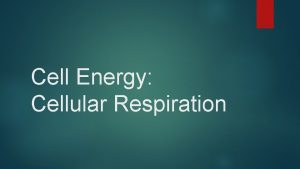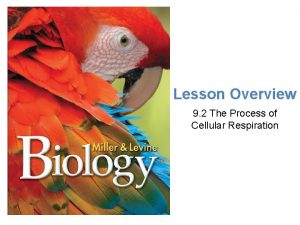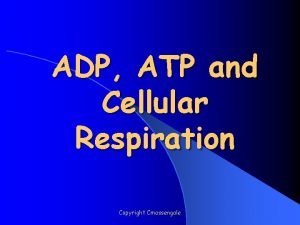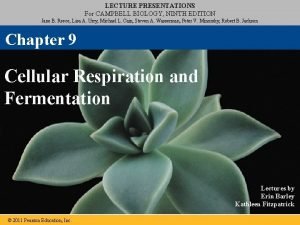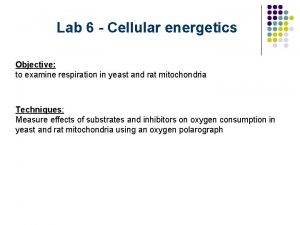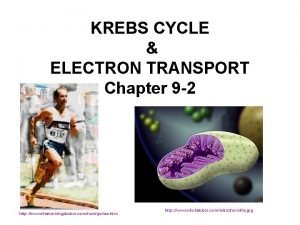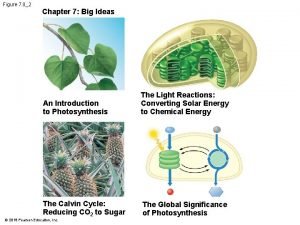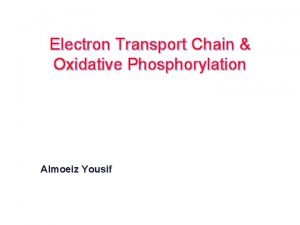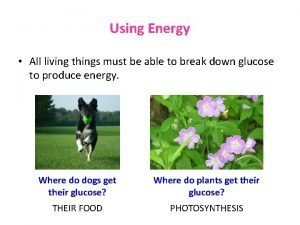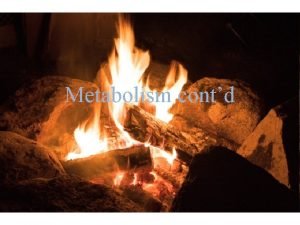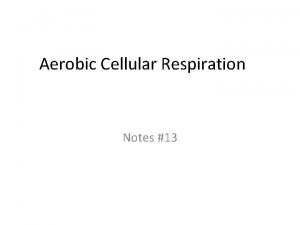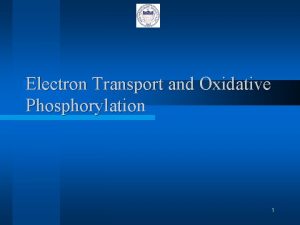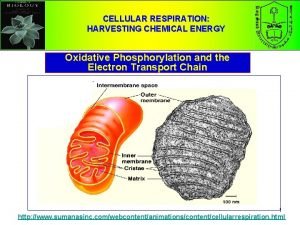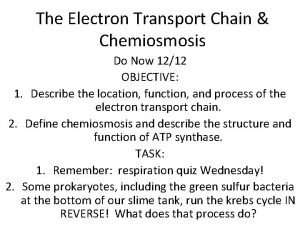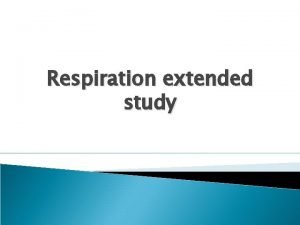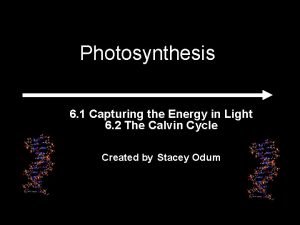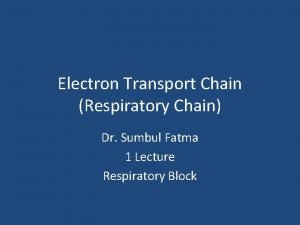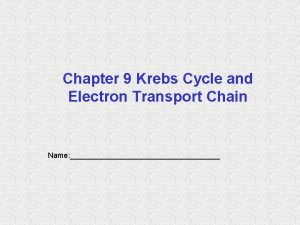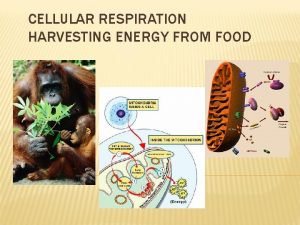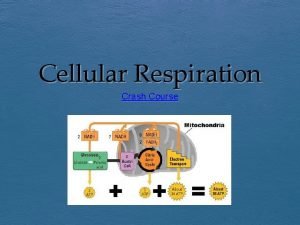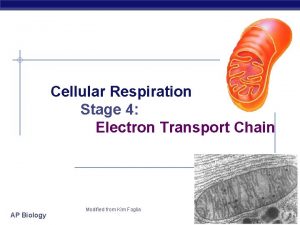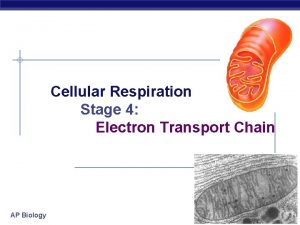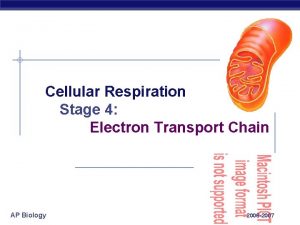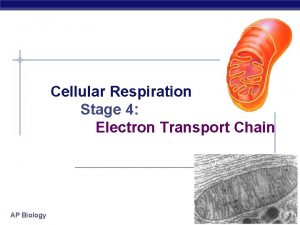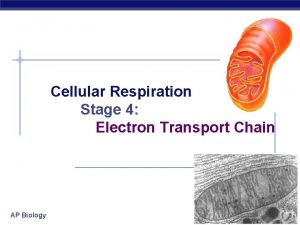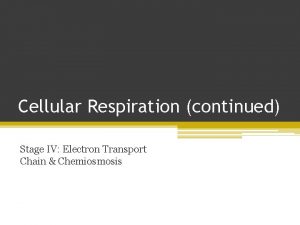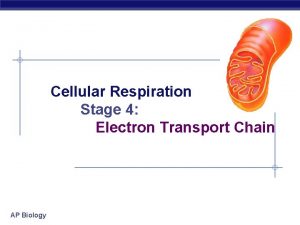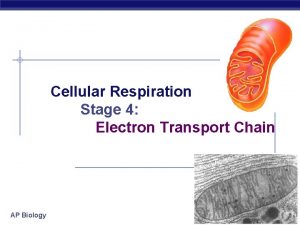Cellular Respiration Stage 4 Electron Transport Chain AP




















- Slides: 20

Cellular Respiration Stage 4: Electron Transport Chain AP Biology 2006 -2007

Cellular respiration AP Biology

What’s the point? The point is to make ATP! ATP AP Biology 2006 -2007

ATP accounting so far… § Glycolysis 2 ATP § Kreb’s cycle 2 ATP § Life takes a lot of energy to run, need to extract more energy than 4 ATP! There’s got to be a better way! I need a lot more ATP! AP Biology A working muscle recycles over 10 million ATPs per second

There is a better way! § Electron Transport Chain u series of proteins built into __________________ § along cristae § transport proteins & enzymes transport of electrons down ETC linked to pumping of H+ to create H+ gradient u yields ______ from 1 glucose! u only in presence of O 2 (_________) u AP Biology That sounds more like it! O 2

Mitochondria § Double membrane outer membrane u __________ u § highly folded cristae § enzymes & transport proteins u __________ § fluid-filled space between membranes AP Biology Oooooh! Form fits function!

Electron Transport Chain Inner mitochondrial membrane Intermembrane space C Q NADH dehydrogenase cytochrome bc complex Mitochondrial matrix AP Biology cytochrome c oxidase complex

Remember the Electron Carriers? Glycolysis 2 NADH Time to break open the piggybank! AP Biology glucose Krebs cycle G 3 P 8 NADH 2 FADH 2

Electron Transport Chain Building proton gradient! NADH NAD+ + H e p intermembrane space H+ H+ H e- + H+ C e– NADH H FADH 2 NAD+ NADH dehydrogenase inner mitochondrial membrane e– Q AP Biology H+ e– H FAD 2 H+ + cytochrome bc complex 1 2 O 2 H 2 O cytochrome c oxidase complex mitochondrial matrix What powers the proton (H+) pumps? …

Stripping H from Electron Carriers § Electron carriers pass electrons & H+ to ETC u u H cleaved off NADH & FADH 2 electrons stripped from H atoms H+ (protons) § electrons passed from one electron carrier to next in mitochondrial membrane (ETC) § flowing electrons = energy to do work u transport proteins in membrane pump H+ (protons) across inner membrane to intermembrane space H+ TA-DA!! Moving electrons do the work! H+ H+ H+ H H+ C e– NADH AP Biology H+ Q e– FADH 2 FAD NAD+ NADH dehydrogenase e– 2 H+ cytochrome bc complex + 1 2 O 2 H 2 O cytochrome c oxidase complex ADP + Pi ATP H+

But what “pulls” the electrons down the ETC? O 2 AP Biology electrons flow downhill to O 2 oxidative phosphorylation

Electrons flow downhill § Electrons move in steps from carrier to carrier downhill to ______ each carrier more electronegative u controlled oxidation u controlled release of energy u make ATP instead of fire! AP Biology

“proton-motive” force We did it! § Set up a H+ § § H+ H+ gradient Allow the protons to flow through ATP synthase Synthesizes ATP ADP + Pi ATP Are we there yet? AP Biology H+ H+ H+ ADP + Pi ATP H+

Chemiosmosis § _____________________ u build up of proton gradient just so H+ could flow through ATP synthase enzyme to build ATP ________ links the Electron Transport Chain to ATP synthesis So that’s the point! AP Biology

1961 | 1978 Peter Mitchell § Proposed chemiosmotic hypothesis u revolutionary idea at the time proton motive force 1920 -1992 AP Biology

Pyruvate from cytoplasm Inner mitochondrial H+ membrane H+ Intermembrane space Electron transport C system Q NADH Acetyl-Co. A 2. Electrons provide energy 1. Electrons are harvested to pump protons and carried to the transport across the system. membrane. - NADH Krebs cycle e- e FADH 2 e- ATP Mitochondrial matrix AP Biology e- H 2 O 3. Oxygen joins with protons to form water. 1 O 2 +2 2 H+ O 2 H+ CO 2 2 H+ 32 ATP 4. Protons diffuse back in down their concentration gradient, driving the synthesis of ATP. H+ ATP synthase

~4 0 A Cellular respiration 2 ATP AP Biology + 2 ATP + ~36 ATP TP

Summary of cellular respiration C 6 H 12 O 6 + 6 O 2 § § § § 6 CO 2 + 6 H 2 O + ~40 ATP Where did the glucose come from? Where did the O 2 come from? Where did the CO 2 go? Where did the H 2 O come from? Where did the ATP come from? What else is produced that is not listed in this equation? § Why do we breathe? AP Biology

Taking it beyond… § What is the final electron acceptor in H+ H+ H+ C Electron Transport Chain? e– O 2 NADH Q e– FADH 2 FAD NAD+ NADH dehydrogenase e– 2 H+ + cytochrome bc complex 1 2 O 2 H 2 O cytochrome c oxidase complex § So what happens if O 2 unavailable? § ETC backs up nothing to pull electrons down chain u NADH & FADH 2 can’t unload H u AP Biology § ATP production ceases § cells run out of energy § and you die!

What’s the point? The point is to make ATP! ATP AP Biology 2006 -2007
 Electron transport chain cellular respiration
Electron transport chain cellular respiration Electron transport chain cellular respiration
Electron transport chain cellular respiration What happens during glycolysis
What happens during glycolysis Electron carriers in cellular respiration
Electron carriers in cellular respiration Electron transport chain campbell
Electron transport chain campbell Azide electron transport chain
Azide electron transport chain Krebs cycle vs electron transport chain
Krebs cycle vs electron transport chain Electron transport chain
Electron transport chain Inhibitors of oxidative phosphorylation
Inhibitors of oxidative phosphorylation Where does the electron transport chain take place
Where does the electron transport chain take place Catabolism
Catabolism Output of electron transport chain
Output of electron transport chain Electron transport chain
Electron transport chain Cellular respiration harvesting chemical energy
Cellular respiration harvesting chemical energy Chemiosmosis steps
Chemiosmosis steps Significance of electron transport chain
Significance of electron transport chain Labelled
Labelled Components of etc
Components of etc Krebs cycle animation
Krebs cycle animation Citric acid cycle and electron transport chain
Citric acid cycle and electron transport chain Crash course electron transport chain
Crash course electron transport chain

